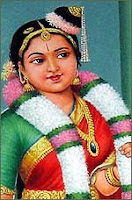
The Tiruppavai is a collection of thirty stanzas (paasuram) in Tamil written by Andal, in praise of the God Tirumal or Vishnu. It is part of Divya Prabandha, a work of the twelve Alvars, and is important in Tamil literature.
Pavai Genre
Tiruppavai belongs to the Pavai genre of songs, a uniquely Tamil tradition sung in the context of the Pavai vow observed throughout the month of Maarkazi, originally by unmarried girls praying to the Pavai goddess (related to Parvati) for a blissful married life. Sri Vaishnavas sing these stanzas every day of the year in the temple as well as in their homes. This practice assumes special significance during Margazhi: each day of this month gets its name from one of the thirty verses. There are references to this vow in the late-sangam era Tamil musical anthology Paripadal.
Andal's thirty songs contain the cardinal principles of Vaishnava dharma during the month of Maarkazi. Tamil Vaishnavas sing these songs to bring peace, prosperity and Divine Grace. Andal assumes the guise of a cowherd in these 30 verses. Andal appears intent upon performing a particular religious vow to marry the Lord, thereby obtain His everlasting company, and inviting all her girl-friends to join her. Towards the end we learn that she did not actually perform a religious rite; but is simply praying to be granted the service of the Lord for eternity. She yearns for everlasting happiness and service of the Lord.
Overview
The first five stanzas provide an introduction to the main theme, its principle and purpose. According to Andal one should give up luxuries during this season. Sincere prayers to the God would bring abundant rain and thus prosperity. Offering Lord Krishna fresh flowers would expiate sins committed earlier and those that may be committed in future.
In the next ten stanzas she describes the importance of community participation. She invites her friends to gather flowers. She essays the ambience at her village, the chirping of birds, colorful blossoms, the musical sound of butter-churning, herds of cattle with tinkling bells, the sounding of the conch from the temple.
She visits each household and awakens all her friends to join her for a bath in a nearby pond. She also praises the incarnations of the Lord. The next five stanzas describe her visit to the temple accompanied by her friends. She desires to render Suprabhata gently to wake up the Lord. The group appeases the temple guards, enters the temple and recites prayers extolling the parents of Lord Krishna and begging them to wake up Krishna and Balarama. Then they approach Neela Devi, the consort of the Lord, to have a darshan.
The last nine stanzas are on the glories of the Lord. On receiving his blessings Andal lists her demands; milk for the vrata, white conch, lamps, flowers, and rich costume and jewellery, plenty of ghee and butter. The concluding stanza is an envoie identifying her as the daughter of Vishnucittar who made this garland of 30 pasurams and says those who recite with devotion will have Lord’s blessings.













